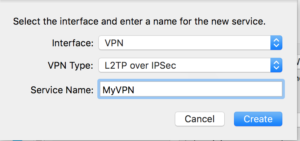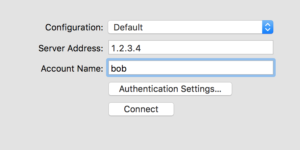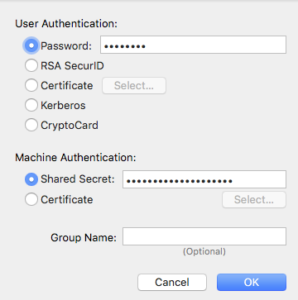Last updated at Wed, 06 Dec 2017 20:49:36 GMT
Synopsis:
We will look at how to configure an L2TP over IPSEC VPN using OpenSWAN and how to connect to it using Mac OSX. This guide is written for running the VPN software on a CentOS 7 x86_64 EC2 instance (ami-6d1c2007) provided by Amazon Web Services. The VPN will be configured to use local authentication and a pre-shared key. This is a great way to allow access into your AWS VPC.
Procedure:
The procedure is broken into 3 parts:
- AWS – Create an EC2 instance
- VPN – Configure the server
- Client – Configure an OSX VPN client
AWS Configuration:
Create a new EC2 instance with an image of ami-6d1c2007 or similar. Assign it a public Elastic IP and create a security group with the following settings to allow the VPN protocols.

If you were to deploy the EC2 instance via Terraform, the configuration would like similar to the example below.
resource "aws_security_group" "nat" {
name = "nat"
description = "Allow services from the private subnet through NAT"
ingress {
from_port = 0
to_port = 0
protocol = "-1"
cidr_blocks = ["10.0.0.0/8"]
}
ingress {
from_port = 0
to_port = 65535
protocol = "tcp"
cidr_blocks = ["${aws_subnet.us-east-1b-private.cidr_block}"]
}
egress {
from_port = 0
to_port = 0
protocol = "-1"
cidr_blocks = ["0.0.0.0/0"]
}
vpc_id = "${aws_vpc.default.id}"
}
resource "aws_security_group" "vpn" {
name = "vpn"
description = "Allow SSH, IPSec and L2TP traffic"
ingress {
from_port = 0
to_port = 0
protocol = "-1"
cidr_blocks = ["10.0.0.0/8"]
}
ingress {
from_port = 1701
to_port = 1701
protocol = "udp"
cidr_blocks = ["0.0.0.0/0"]
}
ingress {
from_port = 500
o_port = 500
protocol = "udp"
cidr_blocks = ["0.0.0.0/0"]
}
ingress {
from_port = 4500
to_port = 4500
protocol = "udp"
cidr_blocks = ["0.0.0.0/0"]
}
egress {
from_port = 0
to_port = 0
protocol = "-1"
cidr_blocks = ["0.0.0.0/0"]
}
vpc_id = "${aws_vpc.default.id}"
}
resource "aws_instance" "nat" {
ami = "ami-6d1c2007"
availability_zone = "us-east-1b"
instance_type = "t2.small"
key_name = "${var.aws_key_name}"
security_groups = ["${aws_security_group.nat.id}", "${aws_security_group.vpn.id}"]
subnet_id = "${aws_subnet.us-east-1b-public.id}"
associate_public_ip_address = true
private_ip = "10.0.0.5"
source_dest_check = false
}
resource "aws_eip" "nat" {
instance = "${aws_instance.nat.id}"
vpc = true
}
VPN Configuration:
We need to configure the following pieces of software to provide a working VPN service.
- RNGD – Random Number Generator Daemon
- OpenSWAN – IPSEC implementation for VPNs
- XL2TPD – L2TP implementation
RNG
First, we will install the random number generator service (RNG) which OpenSWAN can take advantage of to create strong random numbers.
yum install rng-tools
There’s not always a hardware generator available in virtual machines so to avoid potential errors, the contents of /etc/sysconfig/rngd should contain the following:
EXTRAOPTIONS="--no-tpm=1 --quiet -r /dev/urandom"
Now, start the RNG service
systemctl start rngd
OpenSWAN
Install the OpenSwan package:
yum install openswan
Now that OpenSWAN is installed we can add the IPSEC configuration to /etc/ipsec.conf. Replace the values of leftid and leftsourceip with the private IP address of the EC2 instance.
version 2.0
config setup
dumpdir=/var/run/pluto/
plutostderrlog=/var/log/pluto.log
nat_traversal=yes
virtual_private=%v4:192.168.0.0/24,%v4:172.16.0.0/12
oe=off
protostack=netkey
nhelpers=0
interfaces=%defaultroute
conn L2TP-PSK
auto=add
left=%defaultroute
leftid=10.0.0.5
leftsourceip=10.0.0.5
leftnexthop=%defaultroute
leftprotoport=17/%any
rightprotoport=17/%any
right=%any
rightsubnet=vhost:%no,%priv
forceencaps=yes
authby=secret
pfs=no
type=transport
auth=esp
dpddelay=30
dpdtimeout=120
dpdaction=clear
Now, we need to add an IPSEC secrets file. The file should contain both the public IP and private IP address of the EC2 instance. Replace the IP address values below as well as the pre-shared key with something much stronger. The key will be used by the clients to authenticate to the server.
10.0.0.5 %any : PSK "blah"
1.2.3.4 %any : PSK "blah"
The IPSEC service will not pass validation unless we disable reverse path filtering, the sending of ICMP redirects, and the reception of ICMP redirects in the kernel for all interfaces.
for interface in all default eth0 lo; do
sysctl -w net.ipv4.conf.${interface}.send_redirects=0
sysctl -w net.ipv4.conf.${interface}.accept_redirects=0
sysctl -w net.ipv4.conf.${interface}.rp_filter=0
done
Next, we must allow IP forwarding in the kernel.
sysctl -w net.ipv4.ip_forward=1
After, we must enable Proxy ARP for all interfaces.
for interface in all default eth0 lo; do
sysctl -w net.ipv4.conf.${interface}.proxy_arp=1
done
At this time we can start the IPSEC service and verify its configuration.
systemctl start ipsec
ipsec verify
If everything looks good move to the L2TP configuration otherwise troubleshoot by checking the following resources:
ipsec verify
ipsec status --all
cat /var/log/secure
cat /var/log/pluto.log
XL2TPD
Install the L2TP server implementation.
yum install xl2tpd
Configuring the L2TP daemon is easy. Copy the contents to /etc/xl2tpd/xl2tpd.conf and change the value of local ip to the EC2 instance’s private IP address. In addition, you may want to adjust the value of ip range which is the address range handed out to VPN clients. The range should be available addresses within the VPC network.
[global]
port = 1701
[lns default]
ip range = 10.0.0.241-10.0.0.254
local ip = 10.0.0.5
require chap = no
unix authentication = yes
refuse pap = no
require authentication = yes
name = l2tpd
ppp debug = yes
pppoptfile = /etc/ppp/options.xl2tpd
length bit = yes
Now, we need to tell the PPP server to use xl2tpd options. To do this, add the following contents to /etc/ppp/options.xl2tpd. Any DNS server addresses will do for the ms-dns values.
ipcp-accept-local
ipcp-accept-remote
ms-dns 8.8.8.8
ms-dns 8.8.4.4
noccp
auth
crtscts
idle 1800
mtu 1280
mru 1280
lock
connect-delay 5000
name l2tpd
proxyarp
login
logfile /var/log/xl2tpd.log
Next, we will configure the PPP service to use local authentication for users. This means that their user accounts on the VPN server along with the pre-shared key will be used for authentication. Anytime you want to allow a new user to access the VPN you only need to create a new Linux account for them on the server.
Add the following contents to /etc/ppp/pap-secrets:
# Secrets for authentication on server using CHAP
# client server secret IP addresses
* l2tpd "" *
After that we need to configure PAM to allow local authentication by editing the file /etc/pam.d/ppp to only contain:
#%PAM-1.0
auth required pam_nologin.so
auth required pam_unix.so
account required pam_unix.so
session required pam_unix.so
Finally, we can start the L2TP service.
systemctl start xl2tpd
If you encounter any issues check the following log files:
cat /var/log/xl2tpd.log
cat /var/log/messages
Client Configuration:
We will use OSX’s builtin VPN client to connect to the VPN. Begin by selecting System Preferences and then Network. Next, choose the “+” on the bottom left to add a new network interface.

Choose VPN as the interface and select L2TP over IPSEC.

Add the server’s public IP address, a username on the VPN server, and click on Authentication Settings.

For Password, add the user’s server account password and then add the pre-shared key value for Shared Secret.

Apply, and then connect.